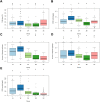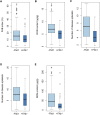Genetic sources and loci for Fusarium head blight resistance in bread wheat
- PMID: 36246592
- PMCID: PMC9561102
- DOI: 10.3389/fgene.2022.988264
Genetic sources and loci for Fusarium head blight resistance in bread wheat
Abstract
Fusarium head blight (FHB) of wheat is an important disease worldwide, affecting the yield, end-use quality and threatening food safety. Genetic resources or stable loci for FHB resistance are still limited in breeding programs. A panel of 265 bread wheat accessions from China, CIMMYT-Mexico and other countries was screened for FHB resistance under 5 field experiments in Mexico and China, and a genome-wide association analysis was performed to identify QTLs associated with FHB resistance. The major locus Fhb1 was significantly associated with FHB severity and Deoxynivalenol content in grains. FHB screening experiments in multiple environments showed that Fhb1-harbouring accessions Sumai3, Sumai5, Ningmai9, Yangmai18 and Tokai66 had low FHB index, disease severity and DON content in grains in response to different Fusarium species and ecological conditions in Mexico and China. Accessions Klein Don Enrique, Chuko and Yumai34 did not have Fhb1 but still showed good FHB resistance and low mycotoxin accumulation. Sixteen loci associated with FHB resistance or DON content in grains were identified on chromosomes 1A, 1B, 2B, 3A, 3D, 4B, 4D, 5A, 5B, 7A, and 7B in multiple environments, explaining phenotypic variation of 4.43-10.49%. The sources with good FHB resistance reported here could be used in breeding programs for resistance improvement in Mexico and China, and the significant loci could be further studied and introgressed for resistance improvement against FHB and mycotoxin accumulation in grains.
Keywords: Fusarium head blight; deoxynivalenol; genetic sources; genome-wide association study; resistance.
Copyright © 2022 Wu, He, He, Jiang, Xu, Zhang and Singh.
Conflict of interest statement
The authors declare that the research was conducted in the absence of any commercial or financial relationships that could be construed as a potential conflict of interest.
Figures





Similar articles
-
Identification of fusarium head blight resistance markers in a genome-wide association study of CIMMYT spring synthetic hexaploid derived wheat lines.BMC Plant Biol. 2023 May 31;23(1):290. doi: 10.1186/s12870-023-04306-8. BMC Plant Biol. 2023. PMID: 37259061 Free PMC article.
-
Identification of QTLs for Resistance to Fusarium Head Blight Using a Doubled Haploid Population Derived from Southeastern United States Soft Red Winter Wheat Varieties AGS 2060 and AGS 2035.Genes (Basel). 2020 Jun 25;11(6):699. doi: 10.3390/genes11060699. Genes (Basel). 2020. PMID: 32630440 Free PMC article.
-
Multi-locus genome-wide association study of fusarium head blight in relation to days to anthesis and plant height in a spring wheat association panel.Front Plant Sci. 2023 Jun 29;14:1166282. doi: 10.3389/fpls.2023.1166282. eCollection 2023. Front Plant Sci. 2023. PMID: 37457352 Free PMC article.
-
Fusarium Head Blight in Durum Wheat: Recent Status, Breeding Directions, and Future Research Prospects.Phytopathology. 2019 Oct;109(10):1664-1675. doi: 10.1094/PHYTO-03-19-0095-RVW. Epub 2019 Sep 3. Phytopathology. 2019. PMID: 31369363 Review.
-
Updating the Breeding Philosophy of Wheat to Fusarium Head Blight (FHB): Resistance Components, QTL Identification, and Phenotyping-A Review.Plants (Basel). 2020 Dec 3;9(12):1702. doi: 10.3390/plants9121702. Plants (Basel). 2020. PMID: 33287353 Free PMC article. Review.
Cited by
-
Molecular Investigations to Improve Fusarium Head Blight Resistance in Wheat: An Update Focusing on Multi-Omics Approaches.Plants (Basel). 2024 Aug 6;13(16):2179. doi: 10.3390/plants13162179. Plants (Basel). 2024. PMID: 39204615 Free PMC article. Review.
References
-
- Arruda M. P., Lipka A. E., Brown P. J., Krill A. M., Thurber C., Brown-Guedira G., et al. (2016b). Comparing genomic selection and marker-assisted selection for Fusarium head blight resistance in wheat (Triticum aestivum L.). Mol. Breed. 36, 84. 10.1007/s11032-016-0508-5 - DOI
-
- Backhouse D. (2014). Global distribution of Fusarium graminearum, F. asiaticum and F. boothii from wheat in relation to climate. Eur. J. Plant Pathol. 139, 161–173. 10.1007/s10658-013-0374-5 - DOI
LinkOut - more resources
Full Text Sources

